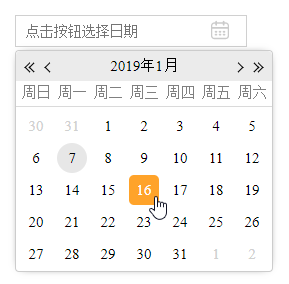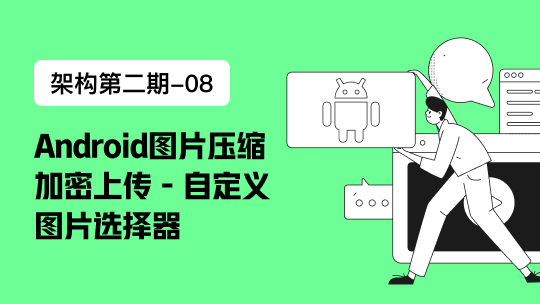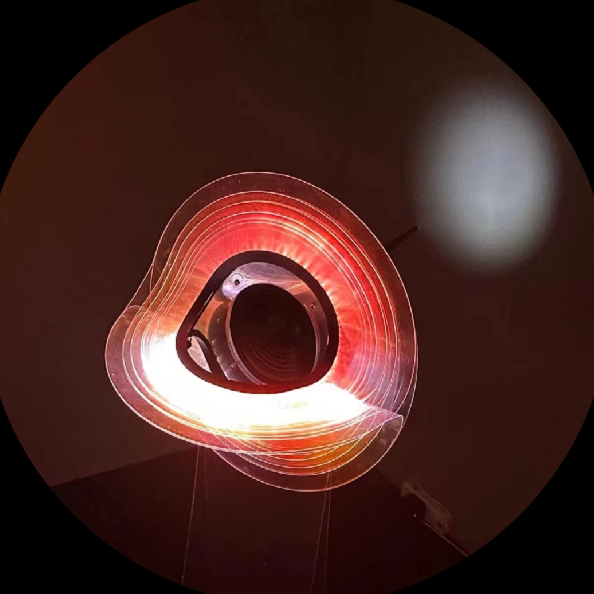日历控件基本上所有的前端都会用到,而且我相信8成的JSer都是直接把开源的组件拿来用,很多设计师似乎跟开发们也有默契,对日历控件只要能用就行,样式啥的不做太多要求,但是某些设计师就是有强迫症,一定要你按着TA的设计来,保不准产品也要舔一把火,往日历里塞些稀奇古怪的业务,咋办?初级开发可能就去网上找符合要求的控件,然后拼命说服他们;普通的开发就可能直接在已有的控件上修修补补,除了问题再回炉重造;高级的开发直接怼回去:什么J8需求,不接!顶级的程序员呢?当然是一言不合直接造轮子啊(笑。
先放最终效果,审美有限,将就着看吧~

先不管js或是jquery怎么写,咱先把日历的样子搭出来
html:
<div id="application">
<div class="date-picker-group">
<input type="text" placeholder="点击按钮选择日期" readonly/>
<i class="trigger"></i>
</div>
<div id="_date-picker" class="calendar-panel" style="left: 120px; top: 135px; display: block;">
<div class="panel-header">
<i class="btn-control prev-year" title="上一年"></i>
<i class="btn-control prev-month" title="上一月"></i>
<span class="YY-MM">2019年1月</span>
<i class="btn-control next-year" title="下一年"></i>
<i class="btn-control next-month" title="下一月"></i>
</div>
<div class="grid" tabindex="0">
<ul class="weekdays">
<li>周日</li>
<li>周一</li>
<li>周二</li>
<li>周三</li>
<li>周四</li>
<li>周五</li>
<li>周六</li>
</ul>
<ul class="days">
<li class="row">
<ul>
<li class="day disabled">30</li>
<li class="day disabled">31</li>
<li class="day">1</li>
<li class="day">2</li>
<li class="day">3</li>
<li class="day">4</li>
<li class="day">5</li>
</ul>
</li>
<li class="row">
<ul>
<li class="day">6</li>
<li class="day today">7</li>
<li class="day">8</li>
<li class="day">9</li>
<li class="day">10</li>
<li class="day">11</li>
<li class="day">12</li>
</ul>
</li>
<li class="row">
<ul>
<li class="day">13</li>
<li class="day">14</li>
<li class="day">15</li>
<li class="day">16</li>
<li class="day">17</li>
<li class="day">18</li>
<li class="day">19</li>
</ul>
</li>
<li class="row">
<ul>
<li class="day">20</li>
<li class="day">21</li>
<li class="day">22</li>
<li class="day">23</li>
<li class="day">24</li>
<li class="day">25</li>
<li class="day">26</li>
</ul>
</li>
<li class="row">
<ul>
<li class="day">27</li>
<li class="day">28</li>
<li class="day">29</li>
<li class="day">30</li>
<li class="day">31</li>
<li class="day disabled">1</li>
<li class="day disabled">2</li>
</ul>
</li>
</ul>
</div>
</div>
</div>
因为层级关系较多,我这里使用scss样式,需要css的小伙伴可以使用这个sass2css转换工具。
scss:
* {
margin: 0;
padding: 0;
outline: none;
}
html, body {
width: 100%;
height: 100%;
}
ul, li {
list-style: none;
}
body {
margin: 0;
padding: 0;
overflow: hidden;
padding-left: 20px;
}
.date-picker-group {
width: 220px;
height: 30px;
border-radius: 50px;
position: relative;
margin: 100px;
& > input {
display: block;
width: 100%;
height: 100%;
line-height: 28px;
border: 1px solid #d0d0d0;
font-size: 14px;
}
& > .trigger {
position: absolute;
top: 0;
right: 5px;
height: 100%;
width: 20px;
background: url("./date_trigger.png") no-repeat center;
background-size: contain;
cursor: pointer;
}
}
#dialog-calendar {
display: none;
font-size: 20px;
position: absolute;
background-color: #fff;
border: 1px solid #ccc;
user-select: none;
border-radius: 4px;
box-shadow: 0 0 15px -7px #000;
& > .panel-header {
text-align: center;
height: 1.5em;
line-height: 1.5em;
position: relative;
background-color: #ebebeb;
border-radius: 5px 5px 0 0;
& > .YY-MM {
display: inline-block;
font-size: 0.75em;
height: 2em;
line-height: 2em;
vertical-align: top;
}
& > .btn-control {
position: absolute;
top: 50%;
width: 6px;
height: 6px;
border: 1px solid #000;
border-top: none;
border-right: none;
transform-origin: center;
cursor: pointer;
&.prev-year {
border-width: 1px;
left: 0.5em;
transform: translateY(-30%) rotate(45deg);
&::after {
content: " ";
display: block;
width: 100%;
height: 100%;
border: 1px solid #000;
border-top: none;
border-right: none;
transform-origin: center;
margin: -3px 0 0 2px;
}
}
&.prev-month {
left: 1.5em;
transform: translateY(-30%) rotate(45deg);
}
&.next-year {
border-width: 1px;
right: 0.5em;
transform: translateY(-30%) rotate(-135deg);
&::after {
content: " ";
display: block;
width: 100%;
height: 100%;
border: 1px solid #000;
border-top: none;
border-right: none;
transform-origin: center;
margin: -3px 0 0 2px;
}
}
&.next-month {
right: 1.5em;
transform: translateY(-30%) rotate(-135deg);
}
}
}
& > .grid {
text-align: center;
& > .weekdays {
/* display: none; */
padding: 0 0.1em;
color: #808080;
border-bottom: 1px solid #dadada;
height: 1.25em;
line-height: 1.25em;
white-space: nowrap;
& > li {
float: left;
width: 2em;
margin: 0 0.2em;
font-size: 0.75em;
height: 1.667em;
line-height: 1.667em;
vertical-align: top;
}
}
& > .days {
padding: 0.1em;
& > .row {
margin-top: 0.1em;
& > ul {
height: 1.5em;
white-space: nowrap;
& > .day {
float: left;
width: 2em;
margin: 0 0.2em;
font-size: 0.75em;
height: 2em;
line-height: 2em;
border-radius: 50%;
text-align: center;
box-sizing: border-box;
cursor: pointer;
&.today {
background-color: #e7e7e7;
&:hover {
background-color: #ffa32a;
}
}
&:hover,
&.focus {
border-radius: 5px;
background-color: #ffa32a;
color: #fff;
}
&.disabled {
color: #d0d0d0;
cursor: default;
&:hover {
background-color: transparent;
color: #d0d0d0;
}
}
}
}
}
}
}
}
样式用em来做单位,可以通过修改根元素.calendar-panel的font-size来调整面板和字体的整体尺寸
最终呈现的效果见下图

重点来了——
首先创建一个DatePicker 类,思考一下这个类会有哪些对外开放的功能,以及哪些必须的私有变量/函数:
构造方法:传入触发元素
开放的api:进入上个月、进入下个月、进入前一年、进入后一年、显示控件、隐藏控件、设置控件位置
内部函数:设置窗体位置,更新窗体年月,更新窗体日期网格、绑定事件
于是先大概组织出这样一个结构
function DatePicker (opts) {
var _this = this
this.$calendar = $('#_calendar-panel') // 日期弹窗
this.$YYMM = this.$calendar.find('.YY-MM') // 顶部年月显示
this.$btnControl = this.$calendar.find('.btn-control') // 头部年月跳转按钮
this.$days = this.$calendar.find('.days') // 日期网格
// 今天的年月日
this.today = new Date()
this.currentYear = this.today.getFullYear()
this.currentMonth = this.today.getMonth() // 月份数组的下标
this.currentDate = this.today.getDate()
// 日历头部显示的年月
this.displayYear = this.currentYear
this.displayMonth = this.currentMonth
// 被选中的年月日
this.selectYear = null
this.selectMonth = null
this.selectDate = null
bindHandlers()
/**
* 进入上个月
*/
this.prevMonth = function () {
}
/**
* 进入下个月
*/
this.nextMonth = function () {
}
/**
* 进入前一年
*/
this.prevYear = function () {
}
/**
* 进入后一年
*/
this.nextYear = function () {
}
/**
* 显示控件
*/
this.showCalendar = function () {
}
/**
* 隐藏控件
*/
this.hideCalendar = function () {
}
/**
* 设置控件位置
*/
this.setPosition = function () {
}
/**
* 更新日期网格数据
*/
function updateDays () {
}
/**
* 更新日历
*/
function update () {
// 更新头部年月数据
// ....
updateDays()
}
/**
* 绑定事件
*/
function bindHandlers () {
}
}
先完成前面几个简单的方法,它们只用来修改DatePicker对象的属性,具体的渲染逻辑放在私有函数update中
/**
* 进入上个月
*/
this.prevMonth = function () {
if (this.displayMonth === 0) {
this.displayMonth = 11
this.displayYear--
}
else {
this.displayMonth--
}
update() // 更新日历
}
/**
* 进入下个月
*/
this.nextMonth = function () {
if (this.displayMonth === 11) {
this.displayMonth = 0
this.displayYear++
}
else {
this.displayMonth++
}
update() // 更新日历
}
/**
* 进入前一年
*/
this.prevYear = function () {
this.displayYear--
update() // 更新日历
}
/**
* 进入后一年
*/
this.nextYear = function () {
this.displayYear++
update() // 更新日历
}
/**
* 显示控件
*/
this.showCalendar = function () {
this.$calendar.css({display: 'block'})
}
/**
* 隐藏控件
*/
this.hideCalendar = function () {
this.$calendar.css({display: 'none'})
}
/**
* 设置控件位置
*/
this.setPosition = function () {
this.$calendar.css({
left: this.$input.offset().left + 'px',
top: (this.$input.height() + this.$input.offset().top + 5) + 'px'
})
}
/**
* 更新日历
*/
function update () {
_this.$YYMM.html(_this.currentYear + '年' + (_this.currentMonth + 1) + '月') // 更新头部年月数据
updateDays()
}
updateDays是我们渲染日期面板的核心方法,先理一下逻辑:
① 首先我们要获取当前需要展示的月份的天数(dayNum)以及该月第一天是星期几(startWeekday)
② 如果不是星期日(0)则获取上个月最后一天的日期(endDateOfLastMonth),将该星期用上个月的最后 startWeekday 天填满
③ 循环填充本月的所有日期,并记录最后一天是星期几(weekday)
④ 如果不是星期六,则从1号开始填完本周剩余 7 - weekday -1 天
按照以上的逻辑,完成了updateDays函数
/**
* 更新日期网格数据
*/
function updateDays () {
var weekday, displayDate
var rowCount = 1
var gridHtmlArray = ['<li class="row"><ul>']
// 插入首行上个月日期
var endDateOfLastMonth = new Date(_this.displayYear, _this.displayMonth, 0).getDate() // 当前展示的年月的上个月的最后一天的日期
var startWeekday = new Date(_this.displayYear, _this.displayMonth, 1).getDay() // 当前展示的年月的第一天是星期几
for (weekday = 0; weekday < startWeekday; weekday++) {
displayDate = endDateOfLastMonth - startWeekday + weekday + 1
gridHtmlArray.push('<li data-day="' + displayDate + '" class="day disabled">' + displayDate + '</li>')
}
// 继续插入后面的日期
var dayNum = new Date(_this.displayYear, _this.displayMonth + 1, 0).getDate() // 当前展示的年月的天数
for (displayDate = 1; displayDate <= dayNum; displayDate++) {
if (displayDate === _this.todayDate && _this.displayMonth === _this.todayMonth && _this.displayYear === _this.todayYear) { // 如果是今天
gridHtmlArray.push('<li data-day="' + displayDate + '" class="day today">' + displayDate + '</li>')
}
else if (displayDate === _this.selectDate && _this.displayMonth === _this.selectMonth && _this.displayYear === _this.selectYear) { // 如果是选中的那天
gridHtmlArray.push('<li data-day="' + displayDate + '" class="day focus">' + displayDate + '</li>')
}
else {
gridHtmlArray.push('<li data-day="' + displayDate + '" class="day">' + displayDate + '</li>')
}
if (weekday === 6 && displayDate < dayNum) {
// 如果到周六还没展示完整月则继续添加行
gridHtmlArray.push('</ul><li class="row"><ul>')
rowCount++
weekday = 0
}
else {
weekday++
}
}
// 用下个月的日期补充玩本周
var fromDate = 1 // 1号开始
for (weekday; weekday < 7; weekday++) {
gridHtmlArray.push('<li class="day disabled">' + (fromDate++) + '</li>')
}
gridHtmlArray.push('</ul></li>')
_this.$days.html(gridHtmlArray.join(''))
}
最后绑定事件:
/**
* 绑定事件
*/
function bindHandlers () {
_this.$calendar.on('click', '.prev-month', function () { _this.prevMonth() })
_this.$calendar.on('click', '.next-month', function () { _this.nextMonth() })
_this.$calendar.on('click', '.prev-year', function () { _this.prevYear() })
_this.$calendar.on('click', '.next-year', function () { _this.nextYear() })
}
后面待补充的功能还有很多,面板定位,dom元素创建,触发事件,事件格式化,jquery封装,挖个坑先~



















